Being a creator is daunting. There’s an entire maze you need to navigate and new information to grasp before you become successful.
We’ve compiled this step-by-step guide of fundamental resources to ensure you know where to start and what you shouldn’t miss on your way of becoming a successful creator. For every step, you will find a brief summary and links to related content and articles here at ForCreators.
STEP 1:
REFINE YOUR IDEA

You can’t be a creator without an idea. But, to be a successful creator you need to refine your idea. When you’re refining your idea always remember this quote by Antoine de Saint-Exupery:
“Perfection is achieved, not when there is nothing more to add, but when there is nothing left to take away.”
You may be overwhelmed by what you want to do, and what you want to achieve through your work, but when you simplify it, you make it less challenging to execute and easy to pivot.
How do you simplify your idea?
You remove the excess, to publish it in its simplest form. This means that you’re going to remove everything that isn’t essential to your creation. If it’s not a fundamental part of your idea and isn’t purposeful, then remove it. This enables you to keep pivoting until your work – your creation – is where you want it to be.
The reason you’re simplifying your idea is to create something successful. Because, for something to be successful, it needs to be within reach and straightforward to explain.
If you’re able to create your idea with tools that are accessible and you can describe what you’re doing in one sentence, your idea is in its simplest form; if not, it’s time to pivot.
Pivoting means to find the center, or essence, of something.
Remember Avril Lavigne’s words here:
“Why’d you have to go and make things so complicated?”
Simplify your idea and it will be easier to set it up, maintain, and grow it.
STEP 2:
ESTABLISH A TEAM AND DEFINE THE ROLES

Once you’ve refined your idea, establish a team, and define the roles.
If you don’t have the means to establish a team – that’s okay – you can execute your idea with clearly defined roles. At this stage, you’ll be carrying out all these roles yourself; when you grow you’ll easily delegate the work to other people.
The Team
This step may not be feasible at the moment, but a team will help you efficiently realize your ideas. Not all team members need financial compensation in the beginning.
However, if you’re not offering financial compensation, are you offering anything of value?
When someone joins your team, what are they receiving in return?
If you think you’re offering them a brilliant deal by giving them exposure, or something similar, first ask yourself would you join a team if that was your only compensation? Be honest. If the answer to that question is “no,” then you need to move onto the next step. However, if you’re able to establish a team with some sort of meaningful value exchange, you need to choose superior teammates.
Your teammates will either help you build what you want to create or destroy it.
Read more about this at ForCreators:
How To Build A Team Without Money
Where To Find Your Team
- Fiverr
Fiverr is a freelance marketplace that facilitates the hiring of freelancers from across the world. If you want to streamline the process or have a large team to manage, working on Fiverr makes the entire process more straightforward. The only caveat is that it’s rare for anyone on Fiverr to think of you as a teammate. They’ll rather see you as a buyer or client. It’s the most basic value exchange that allows you to acquire the expertise of someone else at a predetermined rate. So, don’t expect more than what you’re paying for, or significant long-term collaboration, on the platform.
You can find teammates in Facebook Groups that share the same interests as you. You can discuss with them your ideas as well as compensation. Going to Facebook Groups is an unconventional method of growing your team, but can be effective if you find the right people.
Where else can you DM total strangers? Instagram is an uncomplicated way to reach out to people who are passionate about the things you’re passionate about. It’s also less intimidating as you can reach out via a direct message. The only caveat is that you’re approaching strangers that are likely to be skeptical about whatever you’re asking them to do, as there are thousands of scams doing the rounds on Instagram.
- Recommendations
Ask friends, family, and freelancers you’ve worked with to recommend people they think are suited for the job.
LinkedIn has a network of people looking to partner with, or join, a team of like-minded people, both within a professional capacity and a creative capacity. On LinkedIn you’re able to narrow your search, to find people based on their expertise and location, something other social networks lack.
- IndieHackers
You’ll find amazing creators on Indie Hackers, who are open to collaborate on projects or help each other in some way.
Where Not To Find Your Team
- Google Searches
A Google search is unquestionably the worst place to find teammates for your project. Google isn’t going to show you the best or most compatible teammates, but rather, people who’ve learned to work the algorithm. Sometimes these can be the best people for your work, but oftentimes, especially when you’re starting, these can be the worst.
What To Look For In A Teammate
- Work Ethic
How hard-working are the people you’re approaching? How often are they willing to go the extra mile to get things done?
These are the questions you need to ask yourself and your teammates. Because when you’re starting, you’ll need teammates who are both flexible and professional.
- Knowledge & Expertise
You can’t have a cheerleader teammate. You need a teammate with concrete skills and knowledge. A cheerleader teammate can be described as someone who makes you feel good about your ideas, and is good to bounce ideas off of, but provides limited concrete solutions.
Knowledge and expertise are priceless when you’re beginning your journey as a creator, as these will help you streamline your project.
Another excellent quality a teammate should have is EXPERIENCE. Job experience and life experience are difficult to quantify but add value to the project; value that you may not add yourself.
Try to build a team that doesn’t think the same as you. You’ll find that by diversifying your team, you’ll develop a project or product more people will enjoy.
- Loyalty
In the beginning, it’s vital that you only have loyal teammates. These are the sort of people who won’t steal your ideas or leave you in the lurch. It’s easy to recognize someone who is disloyal. If they’re not as committed to the project as you are or seem to have other priorities, always lording the fact that they’re “helping” you then, chances are, they’re not loyal. These aren’t the kind of teammates you want.
The ideal teammate is passionate, hardworking, and a loyalist. But it is also someone who’ll be honest and share their unbiased opinion of the project with you.
The Roles Within Your Team
Regardless of whether or not you have the means to establish a team, define the roles within your one-man-band.
The term one-man-band is synonymous with creators and entrepreneurs because only one person is completing all the tasks while implying that various positions need to be filled. At the core, creators are entrepreneurs and their job descriptions are lengthy. That’s why it’s essential to identify roles to keep a record of all the work that needs to be completed.
There are three kinds of roles: Primary roles, secondary roles, and luxury or nice to have roles.
Primary roles
Essential roles are roles that are critical to the execution of the project. To be a successful creator, you either need to master the essential roles or have a team who are masters of those primary roles.
To ascertain what a primary role is, ask yourself “what do I need to set up, and manage, my project?” List all the roles that come to mind. You can reduce those positions by determining which tasks are repetitive.
Secondary roles
A supporting role or secondary role assists the primary roles but isn’t central to the execution of the project. Ultimately a secondary role makes the process more efficient by completing less essential tasks.
Nice-To-Have Roles
A nice-to-have role would be one that isn’t essential but would make the production of your project effortless.
These are the roles you can go forever without needing on a full-time, or even part-time, basis but once you expand will enhance your project.
STEP 3:
DETERMINE HOW YOU’RE GOING TO BUILD YOUR COMMUNITY

A creator’s community is paramount to their success. If you truly want to know how to be a successful creator, building your community is only secondary to perfecting your craft. In some instances, you won’t need to perfect your craft because you have a stable community.
Unfortunately, there are no hard-and-fast rules, only guidelines on how to build a community. Building a community will depend on two elements:
1. How authentic you are and,
2. How much value you add.
If you work on being authentic and adding value, you’ll surely succeed at building a community that will enable you to grow.
Being Authentic
Don’t pretend to be something you’re not. Contrary to what you think, people will notice the tiniest details that point to you being disingenuous. More people prefer a person, business, product, or brand that’s honest, forthcoming, and not-fake because it’s more refreshing than putting on a show.
Read more about this at forCreators:
Adding Value
Regardless of what you’re doing or creating, there needs to be an intentional value exchange. Think objectively, as any bias can distort your judgment to the point where you’re thinking you’re adding value that no one else perceives as value.
Even if you’re creating something free to consume, people are going to spend their time consuming what you’re creating, therefore, it shouldn’t be a waste of their time.
You can define your value by answering the question: what are people receiving when they interact with my creation?
The answer can range from being entertained to learning how to create something. Either way, when people consume what you’re creating they need to be getting something they deem valuable.
Decide Where To Build Your Community
You can’t be on too many platforms at once. Choose the one you’re going to focus on. This platform should be the one where you’re most likely to receive exponential growth and reward.
During this phase, do not compare yourself to established creators who are active on Twitter, Instagram, have YouTube channels, TikTok accounts, secondary accounts, and so on.
Usually, they have the resources to manage these and they have a community that wants to engage them on all of these platforms. You don’t have that. That’s not a bad thing. You just need to find where you fit in so you can develop your community there. Once you’ve created a strong community, only then do you need to diversify.
But for now, focus on one social media platform.
This allows you to do more with less. Instead of being all over the place and stretching your resources thin, you’re able to perfect your content and approach on one social media platform, which is something your community will appreciate.
Doing several things poorly will only discourage people from following you or building a community with you.
Focus on one thing. Invest your time in one platform, and growth is inevitable.
Learn How To Leverage Your Current Community
Contrary to popular belief, you don’t need thousands of eyes to be a successful creator, you need the right eyes. The right eyes are the people who won’t keep your content, your project, or your creation to themselves, but will share it and become an ambassador for your brand or project. These are the people that will help you grow as a creator.
Focus on people who are spreading your message, sharing your content and creations with their community, and encourage and reward this type of behavior.
Don’t Be Afraid of Advertising
Organic growth is nearly impossible to accomplish, let alone sustain. Don’t think you’ll seem inauthentic or desperate if you advertise.
Rather, familiarize yourself with smart business practices. One of those smart business practices is advertising. If you’re not able to leverage your existing community or don’t have an existing community, consider advertising.
Advertising will ensure you’re reaching more people. Advertising will also ensure you’re reaching the right kind of people, the kind of people who’ll become ambassadors, but also the kind of people who are easier to monetize.
Several advertising platforms will produce different outcomes and accomplish different results. You can look into each in more detail to determine which is ideal for you. These are:
- Facebook Advertising
- YouTube Advertising
- Google Advertising
- Instagram Advertising
The Most Ineffective Advertising
- Shoutouts:
As a small creator don’t spend your budget on shoutouts. Shout Outs can be described as a person, usually, an influencer, mentioning your business, brand, project, channel, or podcast in a video, story, or post for compensation. In these instances, they’ll usually mention you without any context.
This is the most ineffective method of advertising because people are unlikely to follow you if you’re doing this. Even if they do follow you, you’re not going to get people that are valuable to your growth as a creator.
Instead, if you do want to do Influencer marketing and spend your budget there, choose to do meaningful influencer integrations that have predetermined outcomes.
Read more about this at ForCreators:
How To Increase Social Media Followers
STEP 4:
DEVELOP A STRATEGY

What do you want to accomplish as a creator? The answer to that question should be the essence of your strategy.
You may think a strategy is a complex plan that you need to type out in Times New Roman. That’s not it. A strategy is an uncomplicated approach to achieve simple outcomes.
To create your strategy ask yourself “what do I want to accomplish?”
Start with the most manageable goal. For example, if you’ve got 100 followers now and you want 500 followers, that would be something you want to accomplish.
Once you’ve established what you want to accomplish, you’ll move on to asking yourself the question “How do I attain this?”
When you’re asking yourself this question, think of the answer like you’re giving directions to someone that doesn’t have access to a map.
You want to go from point A (where you are now) to point B (what you want to accomplish.)
What do you need to do to go from point A to point B?
With this information, you can create a strategy.
Your strategy shouldn’t be a formal or lengthy plan, it needs to be concise and precise to be effective. Something you can memorize and recite without too much effort. If you can’t memorize and recite the core elements of your strategy it’s too long. Shorten it and start again.
Read more about this at ForCreators:
STEP 5:
IDENTIFY THE EQUIPMENT YOU’LL NEED

Every creator needs equipment to get started. This can include your office setup, your software, apps, or the equipment that forms an essential part of your job.
Generic Equipment
At the beginning of your journey as a creator, there’s a list of generic equipment you’ll need to ensure your work is running smoothly. This generic equipment will help you remain organized and productive, regardless of the type of creator you are.
- A Planner or Time Tracker
There are several time trackers, team trackers, and collaboration tools that will make your work more manageable and enable you to work more efficiently. Asana.com and Monday.com are two trackers that offer free plans for basic teams and allow you to time track, manage the progress of a project, and collaborate with your team. But if you want a basic time tracking tool, Toggl is an excellent choice to ensure you see which tasks take the most time.
- A Scheduler
You need to find a good social media scheduler, especially if you’re a one-man-band. Digital marketing agencies use them all the time to streamline processes so why shouldn’t you? They’re readily available and extremely affordable and take the hassle out of having to remember to post on respective social media platforms. They also help you plan your content weeks in advance.
We recommend trying Hootsuite or Later, as they enable you to schedule posts to a variety of different networks.
- A Business Phone
Do you know how embarrassing it is to send a personal message to a work contact or receive a personal text or call when you’re in an important business meeting? Those may seem like things that are lightyears away, but, they warrant having a business phone that’s dedicated to your work. Another benefit of having a business phone is that you’ll have more space for photographs, videos, voice notes, and apps that are essential for your work.
Industry-Specific Equipment, Software, and Apps
Never cheap-out on your niche equipment in favor of something else. If you have a budget and are wondering where most of the expense should go it should be equipment, followed only by recruiting a team of experienced professionals and advertising.
Since your equipment is crucial to any project, invest when you can. One thing good equipment will do is improve the quality of your project tremendously. However, if you don’t have the budget, find cost-effective alternatives that will do just as good a job as other pro-level equipment.
You can also look for beginner-friendly alternatives to professional versions as this will give you room to scale when the time comes, without requiring too much capital.
Read more about this at ForCreators:
The Best Podcast Microphone for Beginners
Affordable Twitch Streaming Setup
5 Lesser-Known Tools To Help You Sell Online
5 Best Editing Apps for Instagram
STEP 6:
BEGIN TO MONETIZE YOUR WORK

Being a successful creator is impossible if you don’t complete this step… monetizing your work. Of course, you need to determine how much you want to charge for your services or products, but part of earning more as a creator is to choose payment processors and marketplaces that are most suitable to your needs.
Best Payment Processors for Your Work
There are thousands of payment processors in existence. This post would never end if I were to list them all, so I won’t. I will only list the most popular, and ones you’re most likely going to hear the more you do business as a creator. In the beginning, you only really need one, maybe two, payment processors.
Once you’ve gotten into a rhythm with receiving payments, you’ll see which one people prefer and can use that over the rest.
- Stripe
Stripe charges a 2.9% + $0.30 processing fee for each successful card transaction.
- Paypal
Paypal has a convoluted fee structure which isn’t easy to explain or understand. You can find details about it here.
- Cash App
Cash App isn’t a professional option. But, it can be a simple solution if you’re hiring a freelancer once-off and don’t want to pay Paypal or Stripe’s processing fees.
- FreshBooks
FreshBooks is ideal for freelancers, or artists that primarily do commissions. Freshdesk makes invoicing clients and collaborating with a team uncomplicated. You can track your time spent on a project, upload receipts, and automate estimates, invoices, and late fees. It’s a premium solution that starts at $6 a month and has a processing fee of 2.9% +$0.30.
- Braintree
If you want to accept all the most popular ways to pay but only use one payment processor, Braintree is the solution. Braintree is a Paypal company, but that’s easier to understand. They charge a processing fee of 2.9% + $0.30. You can accept almost every payment method from Apple and Google Pay to Venmo.
- Due
Due.com represents themselves as the cheapest payment processor because their processing fees start at 2.8%. Due is an excellent alternative to FreshBooks, and pricing starts at $7.99 a month on their monthly plan.
- 2Checkout
If you’re building an eCommerce solution or have an e-shop, 2Checkout could be the solution for you. They have plans for every kind of digital business from a common eCommerce store to a more complex subscription model. Their processing fees are the most expensive starting at, 3.5% + $0.35 and they have a list of prohibited items that include a few common items.
Where To Sell:
Marketplaces
Crafts and Handmade Goods
Etsy: Etsy allows you to sell unique crafts. You can sell everything from handmade lipsticks to vintage items on Etsy. Etsy charges a listing fee of $0.20 per product, a 5% transaction fee, and advertising fees if you sell your products through Etsy offsite advertising.
Read more about this at ForCreators:
General Items
- Amazon
You can sell your books, products, and services on Amazon. Amazon gives you greater control of how you can sell, price, and distribute your products. They also charge selling fees, subscription fees, shipping fees, and in instances where Amazon ships the product for you, FBA fees.
Read more about this at forCreators:
Music
- Spotify
Using Distrokid you pay $19.99 to upload your album and keep 100% of the earnings from your music. Distrokid then distributes your music to Spotify, iTunes, Amazon, and Google Play.
- Soundcloud
If you want to test your music sales, Soundcloud is an ideal option. On the free plan, you’re able to upload 3 hours of any type of audio file.
Artwork
- Redbubble
Sell your fabulous designs on popular items. Redbubble allows you to upload your designs and place them on everything from cell phone cases to t-shirts, and wall art. You get to set your artist margins, which are added to the base price for a product determined by Redbubble.
- Society6
Society6 is similar to Redbubble, except they give artists a flat 10% of the price of the item sold. You can learn about what it’s like selling on Society6 in our Society6 Review.
Freelance Services
- Upwork, Freelancer, and Fiverr
Freelancers have a host of options to sell their services. Upwork, Fiverr, and Freelancer happen to be the most popular. They all work similarly. However, unlike Upwork and Freelancer that enable freelancers to be paid hourly and allow them to pitch their work to clients, Fiverr freelancers are paid a predetermined fee based on how much they charge their clients. Regardless of the marketplace you choose, each will have a set of pros and cons.
Photographs
- Getty Images & IStock
Earn royalties from your stock footage and images on Getty and iStock. To be accepted as a contributor, you need to download the Contributor by Getty Images app and submit between 3 and 6 images, illustrations, or videos. The team at Getty will review your submissions, before enabling you to list your work on Getty. On Getty and iStock you get to retain the copyright of your work and earn royalties.
- Shutterstock
On Shutterstock, you can earn between 15% and 40% commission on each license you sell. The more licenses you sell on your images the more you earn. To start publishing your work to Shutterstock, you need to create an account and submit high-quality images for approval by the Shutterstock team.
- 500px
You can also earn a commission from selling your stock images on 500px. Similar to Getty images, 500px has a submission process where you’ll need to submit your work according to their guidelines. If you’re accepted to be a 500px contributor you can earn up to 60% commission every time someone licenses your work.
Read more about this at ForCreators:
Guide To Selling Your Photographs on 500px
STEP 7:
ESTABLISH MEANINGFUL PARTNERSHIPS

Once you gain momentum as a creator, brands, businesses, and other creators will want to partner with you. Even if you’re not the one searching collaboration or places to get brand sponsorships to monetize your influencer. For a partnership to be successful, it needs to meet some fundamental criteria.
Iron-Clad Contract
If you’re partnering with someone, you need to have a contract. If you’re not comfortable signing or creating a contract, be sure everything you agree to is in writing. Don’t think of brands – or your contacts at brands – as your friends. Any partnership they’re participating in has to be beneficial for them, so be sure it’s beneficial for you too. This will spare you from experiencing the horror stories other creators have faced.
Specific Conditions
A contract is redundant if you don’t stipulate specific conditions. These conditions will determine what a brand expects of you and what you expect of the brand. Having these conditions will also make it harder for a brand to renege on a deal without having to pay some sort of restitution or compensation for your time.
Release Clauses
In case you’re not able to continue with a partnership or brand deal, for whatever reason, you should have a release clause in your contract. This enables you – and the brand – to get out of a deal provided certain stipulations are met. If any contract you sign doesn’t have a release clause or has a ridiculous release clause, don’t sign it as you’ll be bound by the contract indefinitely.
Predetermined Fees
Don’t expect brands to help you determine how much you should be making or charging. If you don’t know, most brands will exploit your naivety. Rather do your research on how much you should be earning so you’re not fooled by what some might argue is a good deal. Then, before you agree to any work, ensure that whomever you’re partnering with has agreed to your fees and is willing to pay a non-refundable deposit for the work you’ll be doing.
Getting A Manager
If you don’t want to deal with the red tape and admin part of being a creator, you should think about getting a manager. Your manager doesn’t need to be part of a network, although it does help to have a manager that’s more connected as you can earn more and will be introduced to more creators, brands, and businesses that can ensure you’re able to expand your personal brand and reach more people.
Read more about this at ForCreators:
Complete List of Influencer Agencies





